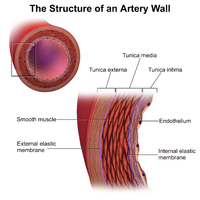
Photo from wikipedia
Despite the high incidence and mortality of cardiovascular events in hyperuricemia patients, the role of serum uric acid in cardiovascular diseases is still controversial. The aim of this meta-analysis was… Click to show full abstract
Despite the high incidence and mortality of cardiovascular events in hyperuricemia patients, the role of serum uric acid in cardiovascular diseases is still controversial. The aim of this meta-analysis was to explore the difference of carotid intima-media thickness in hyperuricemia and control groups. We performed this meta-analysis by searching the PubMed, Cochrane Library, Embase and Web of Science databases up to July 2020. The 95% confidence intervals and standard mean differences were calculated to analyze the differences in carotid intima-media thickness in hyperuricemia groups and control groups. Sensitivity analysis, subgroup analysis and meta-regression were used to explore the sources of heterogeneity. Publication bias was evaluated by funnel plot and Begg’s regression test. We used Stata 14.0 software to complete our analyses. A total of 8 articles were included. The results showed that there was a significant increase in carotid intima-media thickness in the hyperuricemia groups compared with the control groups [SMD = 0.264, 95% CI (0.161–0.366), P < 0.001]. Subgroup analyses showed that age, sample size, blood pressure and body mass index were not the source of heterogeneity. Meta-regression enrolled the method of CIMT measurement, location, age, smoking and diabetes mellitus as categorical variables, but none of these factors was found to be significant in the model. The Begg’s test value (P = 0.174) was greater than 0.05, indicating there was no publication bias. The results showed that carotid intima-media thickness was increased in hyperuricemia patients compared with controls, which indicated that hyperuricemia patients may have a higher risk of cardiovascular diseases.
Journal Title: Aging Clinical and Experimental Research
Year Published: 2021
Link to full text (if available)
Share on Social Media: Sign Up to like & get
recommendations!